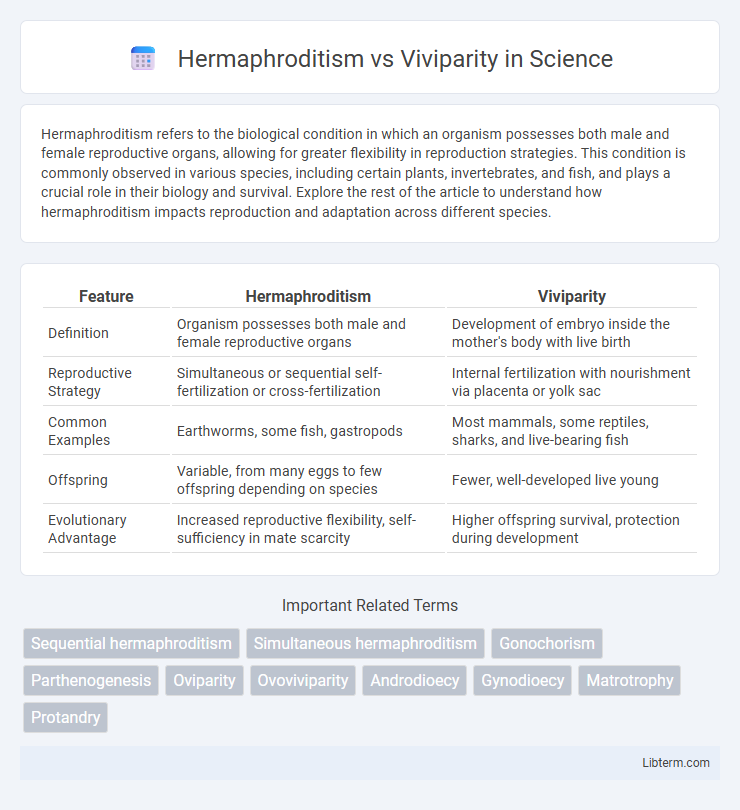Hermaphroditism refers to the biological condition in which an organism possesses both male and female reproductive organs, allowing for greater flexibility in reproduction strategies. This condition is commonly observed in various species, including certain plants, invertebrates, and fish, and plays a crucial role in their biology and survival. Explore the rest of the article to understand how hermaphroditism impacts reproduction and adaptation across different species.
Table of Comparison
| Feature | Hermaphroditism | Viviparity |
|---|---|---|
| Definition | Organism possesses both male and female reproductive organs | Development of embryo inside the mother's body with live birth |
| Reproductive Strategy | Simultaneous or sequential self-fertilization or cross-fertilization | Internal fertilization with nourishment via placenta or yolk sac |
| Common Examples | Earthworms, some fish, gastropods | Most mammals, some reptiles, sharks, and live-bearing fish |
| Offspring | Variable, from many eggs to few offspring depending on species | Fewer, well-developed live young |
| Evolutionary Advantage | Increased reproductive flexibility, self-sufficiency in mate scarcity | Higher offspring survival, protection during development |
Introduction to Hermaphroditism and Viviparity
Hermaphroditism is a biological condition where an organism possesses both male and female reproductive organs, enabling self-fertilization or mating with any member of the species. Viviparity refers to a reproductive strategy involving internal fertilization and embryonic development within the parent, leading to live birth rather than laying eggs. These reproductive adaptations influence survival strategies and ecological interactions across diverse animal taxa.
Defining Hermaphroditism: Biological Overview
Hermaphroditism is a biological condition in which an organism possesses both male and female reproductive organs, allowing it to produce both eggs and sperm. This reproductive strategy is common in various invertebrates such as earthworms and many fish species, facilitating self-fertilization or mating with any individual of the same species. Viviparity, by contrast, refers to a mode of reproduction where embryos develop inside the mother's body leading to live birth, a trait typical of mammals and certain reptiles.
Understanding Viviparity: Key Characteristics
Viviparity is a reproductive strategy where embryos develop inside the parent's body, receiving direct nourishment until birth, contrasting with hermaphroditism, where an organism possesses both male and female reproductive organs. Key characteristics of viviparity include internal fertilization, significant maternal investment during gestation, and live birth, enhancing offspring survival in challenging environments. This reproductive mode is common in many mammals, some reptiles, and a few fish species, illustrating evolutionary adaptations for nurturing young within the parent's body.
Comparative Evolutionary Perspectives
Hermaphroditism and viviparity represent distinct reproductive strategies shaped by evolutionary pressures to maximize reproductive success in diverse environments. Hermaphroditism, common in many invertebrates and some fish, allows self-fertilization or flexible mating roles, enhancing reproductive assurance in low-density populations and promoting genetic diversity. Viviparity, evolved independently in multiple vertebrate lineages, provides increased offspring survival through internal development and maternal resource allocation, reflecting adaptations to stable or competitive habitats where offspring investment enhances fitness.
Reproductive Strategies: Hermaphroditism vs Viviparity
Hermaphroditism is a reproductive strategy where organisms possess both male and female reproductive organs, allowing self-fertilization or mating with any individual of their species, maximizing reproductive flexibility in low-density populations. Viviparity refers to the reproductive mode where embryos develop inside the mother's body, leading to live birth and providing increased offspring protection and higher survival rates in complex environments. These contrasting strategies reflect adaptations to environmental pressures, with hermaphroditism enhancing reproductive assurance and viviparity increasing parental investment and offspring viability.
Occurrence in Animals: Species Examples
Hermaphroditism occurs in species such as earthworms, where individuals possess both male and female reproductive organs, and certain fish like clownfish, which can change sex depending on environmental conditions. Viviparity is common in mammals including humans and dolphins, where embryos develop inside the female's body, receiving direct nourishment until birth. Some reptile species like certain snakes and lizards also exhibit viviparity, giving birth to live young instead of laying eggs.
Adaptive Advantages and Disadvantages
Hermaphroditism provides adaptive advantages such as increased reproductive flexibility, allowing organisms like certain fish and invertebrates to self-fertilize or mate with any individual, enhancing survival in low population densities; however, it often results in energy trade-offs between producing both male and female gametes. Viviparity offers protection and nutrition to developing embryos within the parent, improving offspring survival rates in stable or demanding environments such as those faced by mammals and some reptiles, yet it limits reproductive output due to higher parental investment and longer gestation periods. Both strategies reflect evolutionary trade-offs between reproductive assurance and offspring quantity, shaped by ecological pressures and life history traits.
Genetic and Environmental Influences
Hermaphroditism and viviparity are reproductive strategies influenced by complex genetic and environmental factors. In hermaphroditic species, genes regulate the development of both male and female reproductive organs, allowing flexible reproductive roles, while environmental triggers such as population density and resource availability can modulate gene expression and sexual function. Viviparity involves genetic determinants controlling embryonic development within the mother, with environmental conditions like temperature and maternal nutrition impacting offspring viability and phenotypic traits.
Ecological Implications and Niche Specialization
Hermaphroditism enhances reproductive flexibility, allowing organisms like many gastropods and fish to occupy niches with low population densities by ensuring mating opportunities regardless of partner availability. Viviparity, as observed in several reptiles and mammals, promotes higher offspring survival through internal development, enabling colonization of stable but competitive habitats requiring greater parental investment. Both strategies reflect niche specialization adaptations that optimize reproductive success under specific ecological constraints, influencing population dynamics and community structures.
Future Research and Scientific Insights
Future research in hermaphroditism and viviparity will explore genetic and environmental factors influencing reproductive strategies, leveraging genomic sequencing and epigenetic profiling. Advances in molecular biology and developmental genetics are expected to uncover regulatory pathways controlling sex differentiation and embryonic development in diverse species. Integrating comparative studies across taxa will provide deeper scientific insights into evolutionary adaptations and reproductive plasticity.
Hermaphroditism Infographic

 libterm.com
libterm.com